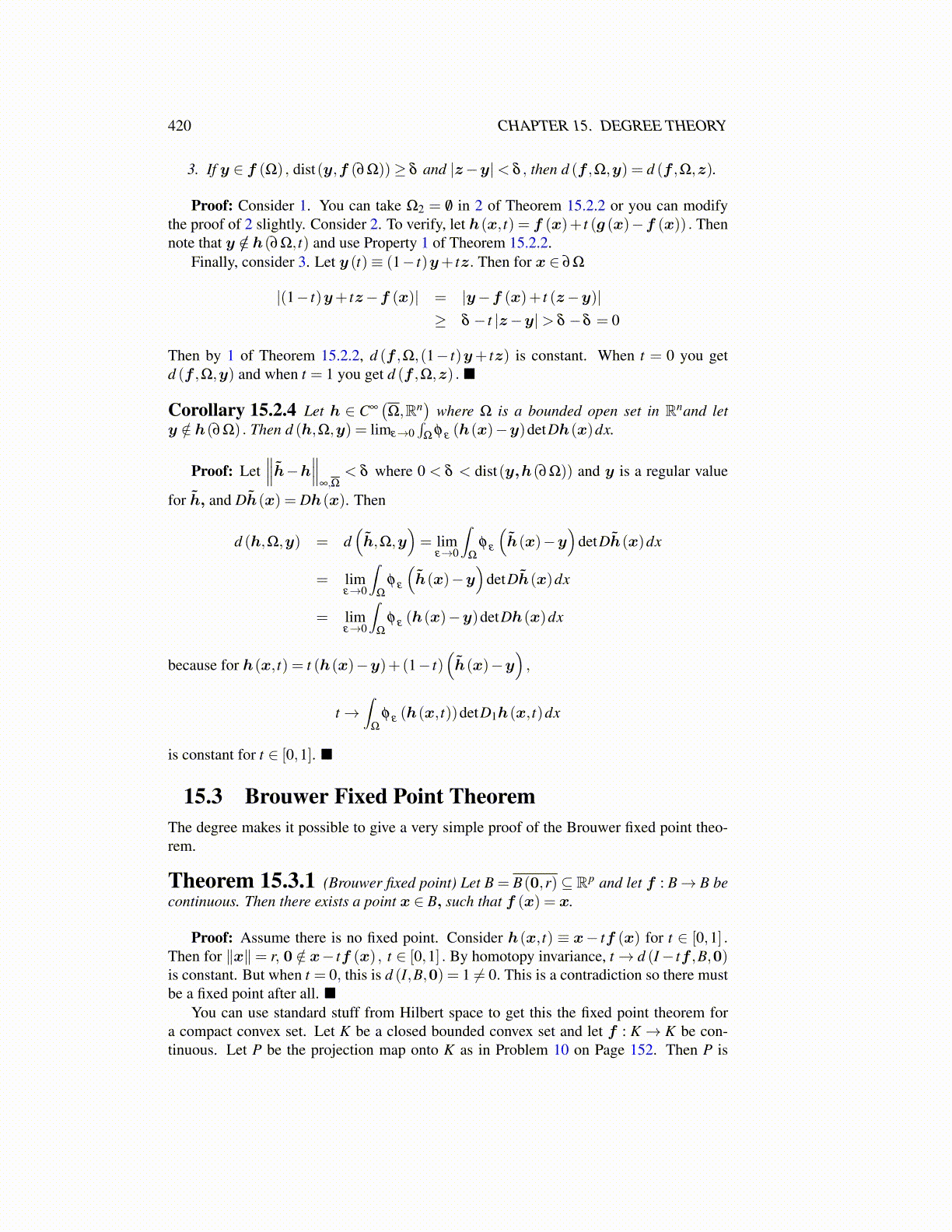
420 CHAPTER 15. DEGREE THEORY
3. If y ∈ f (Ω) , dist(y,f (∂Ω))≥ δ and |z−y|< δ , then d (f ,Ω,y) = d (f ,Ω,z).
Proof: Consider 1. You can take Ω2 = /0 in 2 of Theorem 15.2.2 or you can modifythe proof of 2 slightly. Consider 2. To verify, let h(x, t) = f (x)+ t (g (x)−f (x)) . Thennote that y /∈ h(∂Ω, t) and use Property 1 of Theorem 15.2.2.
Finally, consider 3. Let y (t)≡ (1− t)y+ tz. Then for x ∈ ∂Ω
|(1− t)y+ tz−f (x)| = |y−f (x)+ t (z−y)|≥ δ − t |z−y|> δ −δ = 0
Then by 1 of Theorem 15.2.2, d (f ,Ω,(1− t)y+ tz) is constant. When t = 0 you getd (f ,Ω,y) and when t = 1 you get d (f ,Ω,z) . ■
Corollary 15.2.4 Let h ∈ C∞(Ω,Rn
)where Ω is a bounded open set in Rnand let
y /∈ h(∂Ω) . Then d (h,Ω,y) = limε→0∫
Ωφ ε (h(x)−y)detDh(x)dx.
Proof: Let∥∥∥h̃−h∥∥∥
∞,Ω< δ where 0 < δ < dist(y,h(∂Ω)) and y is a regular value
for h̃, and Dh̃(x) = Dh(x). Then
d (h,Ω,y) = d(h̃,Ω,y
)= lim
ε→0
∫Ω
φ ε
(h̃(x)−y
)detDh̃(x)dx
= limε→0
∫Ω
φ ε
(h̃(x)−y
)detDh̃(x)dx
= limε→0
∫Ω
φ ε (h(x)−y)detDh(x)dx
because for h(x, t) = t (h(x)−y)+(1− t)(h̃(x)−y
),
t→∫
Ω
φ ε (h(x, t))detD1h(x, t)dx
is constant for t ∈ [0,1]. ■
15.3 Brouwer Fixed Point TheoremThe degree makes it possible to give a very simple proof of the Brouwer fixed point theo-rem.
Theorem 15.3.1 (Brouwer fixed point) Let B = B(0,r)⊆ Rp and let f : B→ B becontinuous. Then there exists a point x ∈ B, such that f (x) = x.
Proof: Assume there is no fixed point. Consider h(x, t) ≡ x− tf (x) for t ∈ [0,1] .Then for ∥x∥= r, 0 /∈ x− tf (x) , t ∈ [0,1] . By homotopy invariance, t→ d (I− tf ,B,0)is constant. But when t = 0, this is d (I,B,0) = 1 ̸= 0. This is a contradiction so there mustbe a fixed point after all. ■
You can use standard stuff from Hilbert space to get this the fixed point theorem fora compact convex set. Let K be a closed bounded convex set and let f : K → K be con-tinuous. Let P be the projection map onto K as in Problem 10 on Page 152. Then P is